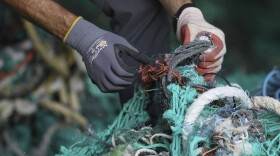The U.S. Army Corps of Engineers says it will modify designs for a controversial flood control project on Oahu. The public will have a chance to further hear about the Ala Wai Flood Control Project on Tuesday.
In a news release last week, the Corps of Engineers Honolulu District said it had incorporated community concerns into the changes to the project, which is designed to protect the Honolulu neighborhoods of Mo’ili’ili, McCully and Waik?k? from a catastrophic rain-fed flood through several water detention basins along mauka streams.
But some residents of Palolo, Makiki, and Manoa – where much of the work will take place -- have expressed opposition to the project.
Honolulu Councilmember Ann Kobayashi, who represents the area, said project skeptics remain cautious until they see the final design plan.
"I think the community is just worried that once an agreement, a partnership is reached, then they could do whatever they want," said Kobayashi. "So we're trying to find that middle ground. Not everyone's going to be happy, of course. You know, none of us want the flooding to occur. We're not against the project and we don't want to lose the federal money. But we just feel there must be a better way. Let's look at alternatives."
In its statement, the Corps of Engineers said that based on community input, it would recommend removing features in Palolo and Upper Makiki that would impact private property.
In a separate interview with HPR, Jeffrey Herzog, the project's manager, clarified that while the Corps of Engineers seeks to address community concerns whenever possible, the changes to the Ala Wai Flood Control design plans were based on new scientific data and analysis.
Herzog said that while the original feasibility study called for earthen detention basins in upper Palolo and Makiki, more recent analysis found that focusing on streams in Manoa Valley will be a more efficient and cost effective approach to flood mitigation for the lower Ala Wai watershed.
Herzog told HPR that he anticipated at least 6 to 9 months of public meetings and scientific review before design plans will be solidified.
Feedback regarding features around the Ala Wai Canal and in Manoa will also be incorporated.
State and federal officials continue to support the project. U.S. Sen. Brian Schatz issued a statement Friday saying he was pleased to see the Corps listening to community concerns in modifying the project.
"We still have a long way to go. This will require that we rebuild trust and listen to each other, but this is nevertheless good news for all involved. This will help us to honor our commitment to keep people in the Ala Wai watershed safe from flood risk in the era of climate change," he said.
Honolulu Mayor Kirk Caldwell has said the local share of funding could come from the state with the issurance of $125 million in certificate of participation bonds. The federal government would foot $220 million for its share of the costs.
By email, Gov. David Ige spokesperson Cindy McMillan said while the decision to proceed with the project is the city's, "the governor's position remains the same -- he supports the project, and the state is willing to provide major financial backing for it."
Several members of the Honolulu City Council will be holding a public meeting on the project at 5:30 p.m. Tuesday at Ala Wai Elementary School.



